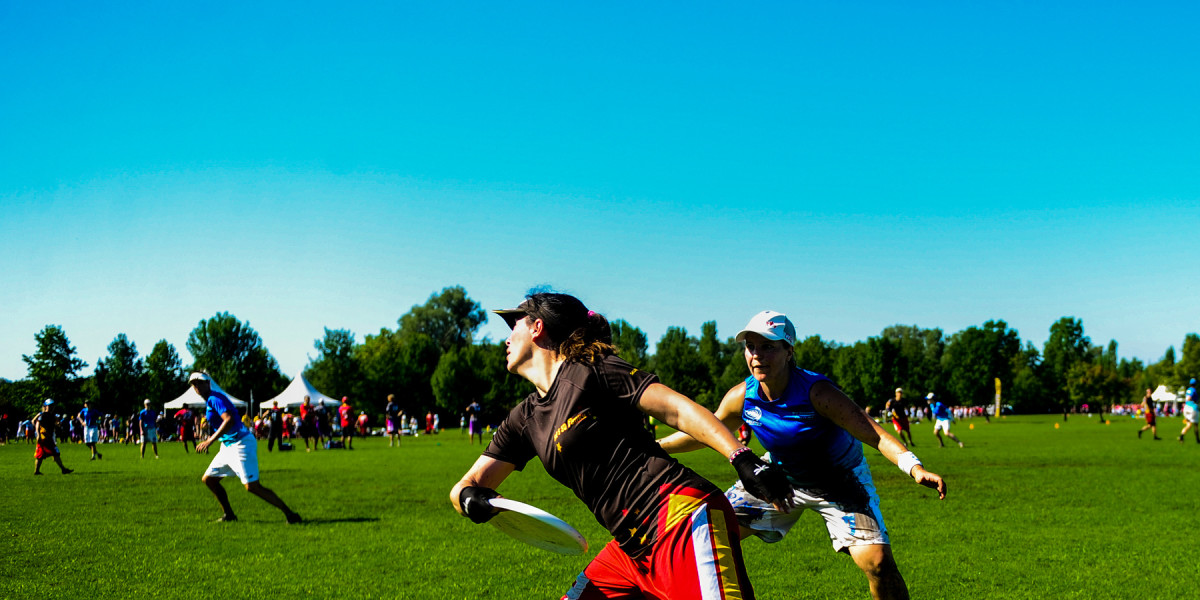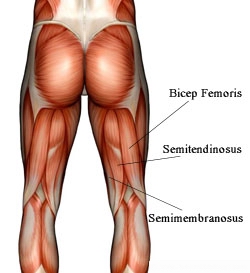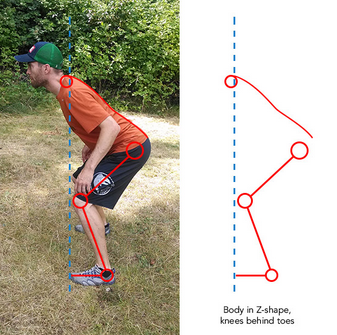 Photo by Brian Canniff of Ultiphotos
Photo by Brian Canniff of Ultiphotos
Whenever I do a clinic on injury reduction and performance prep, the most recent one was in Reno, I always ask what injuries people struggle with the most. Hamstring strains and tears are consistently first on the list, with ankle and shoulder problems coming in second and third, respectively. After working with hundreds (maybe thousands?) of ultimate athletes over the last few years, I feel I’ve got a pretty good handle on how to help players not only reduce the incidence of overuse and acute hamstring strain, but address the movement patterns and postural issues that are the foundation of the problem. And because it’s science, not rocket science, you can learn to evaluate and heal yourself a lot of the time! Not only that, if you take the time to address these issues, you’ll come back more powerful and injury-resistant, instead of more prone to doing the same damn thing next season. Cool, right?
First of all, a quick anatomy lesson – there are three muscles that comprise the hamstrings, and they all attach and insert at different points.

Notice that while all attach at the ischium (sit bones) on the posterior pelvis, two of the three insert at the medial side of the knee and the other attaches to the lateral side. With all the cutting ultimate players do, not to mention the running and lunging, you can see how those muscles work super hard even if your movement and posture are perfect! Most people’s mechanics aren’t perfect, however, and that’s where their problems begin.
In my experience with ultimate players, there are three main causes of hamstring overuse and/or injury: excessive anterior pelvic tilt, poor hip mobility, and a prior hamstring injury. You might have more than one of these problems, of course, and there might be other factors that contribute, but these are the main bad guys.
Let’s look at them individually and see if you can spot the guy behind the guy for your injury/tightness!
Problem: Excessive Anterior Pelvic Tilt
This is one of the main causes of hamstring overuse, and it’s one of the easiest to spot!

Image from Post Direct
Think of the pelvis like a bowl – it can tilt forward, back, side to side, and everywhere in between. When your posture is neutral, the bowl doesn’t spill any water (power). When your pelvis is tipped too far forward, excess energy is lost to the front, and your hamstring tendons (which attach to your pelvis) get pulled upwards. This means that in this postural position, your hamstrings are under constant stretch. If they’re asked to do more than just stand, they’re going to be working extra hard and need to be even more flexible than they would in a normal posture. Also, when the pelvis is tipped forward this way, it becomes really difficult (if not impossible) to properly engage your glutes, your main powerhouse! For a more in-depth look at sport research around this topic, check this out.
I asked my good friend Deb (Cussen) Scheibe, physical therapist extraordinaire, to weigh in on the causes of anterior pelvic tilt. She says, “I think the biggest root cause is a lack of control and strength/endurance from the deep abdominals, specifically the Transverse Abdominus and the Internal Obliques. You can release the psoas, open up hip mobility, etc., but those will just tighten back up if you don’t fix the ab control. In anterior pelvic tilt, the abs are lengthened and weakened. Lately I’ve been going another step deeper toward root cause when it comes to recruiting and retraining these deep abdominals, which is to fix the breathing pattern. If normal diaphragmatic breathing pattern is lost, these abdominals tend to shut down. Fixing breathing pattern and retraining the abs as part of this will not only help with pelvis control, but it will have an added bonus of improved oxygen exchange and cardiovascular endurance.”
Evaluation: Is This Me?
Here’s a video of a simple eval you can do yourself, or better yet, have a friend watch you. Basically, we need to determine if you tilt your pelvis while standing, or if it tilts as soon as you start to move. The second is a stability and patterning problem, while the first is more of a postural concern. If you want/need tactile feedback, Deb has a good suggestion, “Against a wall – if you’re in neutral, you should be able to stand against a wall with contact at your tailbone, midback between the shoulder blades, and back of your head. If you are in anterior pelvic tilt, then you may feel: a) the bottom of your tailbone against the wall, rather than the center to top of tailbone; b) an excessive space between the wall and your low back – if you slip your hand behind your back, it shouldn’t be much more space than that.
Okay, This Is Me: Now What?
Here are some corrective steps you can do that will help address the problem. Pay special attention to when/how much to do them, and take before/after pics and videos so you can see if you’re improving!
- Rib Pull – This movement focuses just on breathing while maintaining a neutral spine
- Deadbugs – Pay special attention to the parts of your body touching the ground: back of head, both shoulder blades, mid-back and sacrum. Keep checking to make sure there’s a small space between your low back and the floor, and that the space doesn’t get smaller or bigger as you move! Also, focus on breathing into all the spaces (front, back, and sides) of your core between your lower ribs and your hips.
- Progress the deadbugs to Resisted Deadbugs and/or Plank Pulls when you can! Then start playing around with hip hinge movements (KB Deadlift or other DL movements), really focusing on engaging those deep inner core muscles and maintaining proper alignment.
Problem: Poor Hip Mobility
There is a reason why I evangelize about hip mobility (So much that it’s kind of become my tagline). It’s because it’s really important. Your hips might be tight from simply not moving through a big enough range of motion on a daily basis (desk job, lots of driving), or maybe just from all the demands of ultimate (explosive sprinting, cutting, throwing). I’m borrowing these example images from a previous article I wrote about low defensive stance because they illustrate the point well:

Good hip mobility

Not great: excessive knee bend = poor glute engagement.

Poor hip mobility (compensates with spine curve)
If your hips are locked (Or worse, if one of them is and one of them isn’t), no amount of hamstring flexibility will decrease the wear and tear. When you mark/lunge/change directions/open up your stride to get to top speed, you’re overusing your hamstrings and underutilizing your glutes. In addition, your range of motion on squats and deadlift (both double and single leg) will be limited.
Evaluation: Is This Me?
Here are a couple movements to test (Frog Stretch and Active Straight Leg Raise). You might struggle with one and not the other. If you’re feeling hamstring strain when lunging, it’s probably more likely that you’ll struggle with the Frog Stretch.
Okay, This Is Me: Now What?
If you work on these correctives diligently, like every day, you should see an improvement in the testing fairly soon!
- Soft Tissue Work for legs/hips/glutes – get loose!
- Straight-Leg Hip Mobility – I do these with my RenFit classes almost every time – really work to keep both legs totally straight and a little bit of space underneath your low back!
You have to also work to get your functional hip mobility up to snuff – that means getting your new-and-improved mobility into movement, and then into field movement. Here’s a couple good warm ups to get the right muscles firing!
- Hip Flexor Trio – Can you lift your front leg up without your hip flexor cramping? If not, you need more soft tissue and deep core work!
- 3-Way Lunge Matrix – Make sure at every point you’re asking your hips to deepen the movement, not your low back or your knees
Problem: Prior Hamstring Injury
It’s said that the greatest indicator of an injury is a previous injury in the same area. This may seem like a no-brainer, but it has to be acknowledged and addressed! In my opinion, the biggest causes of acute hamstring injuries in ultimate players are incomplete rehab and returning to play too fast. You HATE sitting out of games and practices, so as soon as you feel okay jogging around, you jump back in. But when you hit top speed or change directions explosively, there’s a good chance you’ll go down.
Evaluation: Is This Me?
Are you ready to return to play? Luckily, the test for this is extremely black and white:
If you have pain or weakness in any type of motion (eccentric, isometric or concentric, if your strength is more than 20% asymmetrical), you’re not ready to play yet. One of many studies on hamstring injury claims, “The rate of muscle injury was significantly increased in subjects with untreated strength imbalances in comparison with players showing no imbalance in preseason.”
Okay, This Is Me: Now What?
First, you have to regain muscle/tendon health and strength (which takes time and patience). Getting your hamstring strong again is the simple part, not that it’ll be EASY, but it’ll be simple:
- Hamstring rehab protocol – You’ll notice this is the same framework as the test you performed. You’ll be able to see progress really clearly; once you can complete all three kinds of movements with the same amount of weight and no pain, you’re good to go.
- Soft tissue work – Do this along with the protocol and you’ll progress much faster!
- Voodoo X-band – My favorite sideline tool, great for unsticking the stuck parts of your hamstring. You can do this before practice or lifting to decrease the strain on the weaker areas!
- Hamstring strengthening – This is a less equipment-driven option for strengthening, but it should NOT replace the protocol. The protocol is the best and most measureable way of determining whether you’re improving and how far you have to go.
Secondly, you have to fix the underlying problem if there is one (like poor hip mobility or excessive anterior tilt). Getting your hamstring back to 100% is a priority, but if you have one of these foundation-level problems, no amount of hamstring strength will protect you from injuring it again. Once your acute injury is resolved, explore the two problems in the first part of the article – knowledge is power!!
Like I said, it’s science, not rocket science. You have the ability to overcome these issues and become more injury-resistant and badass. You just have to want it badly enough to do the dirty work.











Comments Policy: At Skyd, we value all legitimate contributions to the discussion of ultimate. However, please ensure your input is respectful. Hateful, slanderous, or disrespectful comments will be deleted. For grammatical, factual, and typographic errors, instead of leaving a comment, please e-mail our editors directly at editors [at] skydmagazine.com.